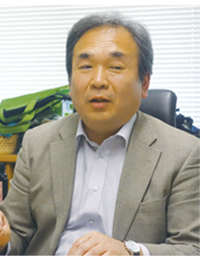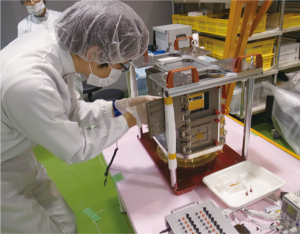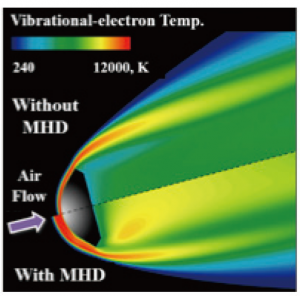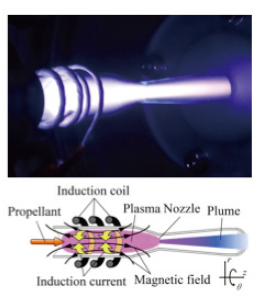他のメンバー : 阿部 豊 磯部 大吾郎 岡島 敬一 河井 昌道 金子 暁子 若槻 尚斗 松田 哲也 松島 亘志 水谷 孝一 石田 政義 中内 靖 坪内 孝司 藤野 貴康 武若 聡
キーワード: 宇宙工学、宇宙芸術、宇宙医学、生命環境、体育
http://utseed.kz.tsukuba.ac.jp
 現代の宇宙利用の潮流をいち早く意識化し、分野を横断した学際的な「宇宙開発」の研究を行
現代の宇宙利用の潮流をいち早く意識化し、分野を横断した学際的な「宇宙開発」の研究を行
います。宇宙技術(推進・空力・熱・環境・ロボット)を創造し次世代の宇宙開発に貢献します。
総合科学技術力としての宇宙開発
宇宙開発は多様な分野の集結が必要であり醍醐味です。JAXA筑波宇宙センターの近隣に位置する総合大学という地の利をもつ筑波大の研究者にとって、JAXAは魅力的な共同研究先です。しかし、“隣の芝生は青い”の言葉通り、宇宙開発に特化した秀逸な研究環境を誇るJAXAから見ると筑波大学の学問守備範囲の広さは、研究所で望んでも得られない得難い貴重なリソースです。ひとたび宇宙に飛び出せば、そこには今まで問えなかった様々な可能性が学問領域に
渡って展開します。宇宙で生体はどういう影響を受けるか(医学)、無重力の空間でどんな新しい表現が可能か(芸術)、、、そのようなあらゆる学問リソースがふんだんに有るのが、専門分野の研究所からみた大学の魅力なのです。そんなJAXAからのラブコールを受けて学内に広く声をかけると、生命環境系の奈佐原先生、陽子線医学利用研究センターの桜井先生、芸術系の逢坂先生からも次々と手があがり、電波天文学の他に、宇宙から農作地をリーモートセンシング
する研究、無重力状態での宇宙芸術といった広範なトピックを紹介する「筑波宇宙フロンティアフォーラム」が開かれました。
専門家の緩やかな結集

図1:超小型衛星(結)の装填
私が最も得意とするのはシミュレーション手法が力を発揮できる穏やかな燃焼現象ですが、先ごろ名古屋大学に移られた笠原先生はマッハ10のすさまじい速さで爆発するデトネーションを利用した新しいロケットエンジンを専門にしていました。また、メンバーの亀田先生は土木系の出身ですが、学生が作る超小型衛星「結」のプロジェクト(図1)のリーダーとしてJAXAとの共同研究開発を進めました。電気系出身で電磁流体力学の専門家の藤野先生は再突入時の衝撃波を緩和する電磁的方法(図2)を研究、そして新たに加わった若手研究者の横田先生と嶋村先生はそれぞれ、電気推進(はやぶさのイオンエンジン等)(図3)、およびレーザー推進という全く新しい発想の宇宙推進機を専門としています。各専門家が、自分の分野に没頭しつつも宇宙を軸に緩やかに関係する「場」を育みたいと思っています。

図2:MHD による再突入時の流れの制御

図3:ICP 電熱型電気推進
社会への貢献・実績
● 電波天文学から芸術まで「宇宙」に関する話題を紹介する 「筑波宇宙フロンティア フォーラム」開催
A group of experts from various fields for research on space exploration
Unit members : Abe, Yutaka Isobe, Daigoro Okajima, Keiichi Kawai, Masamichi Kaneko, Akiko Wakatsuki, Naoto Matsuda, Tetsuya Matsushima, Takashi Mizutani, Koichi Ishida, Masayoshi Nakauchi, Yasushi Tsubouchi, Takashi Fujino Takayasu Takewaka, Satoshi
Unit name: Interdisciplinary Research Unit for Space Development
Key words: space engineering, space art, space medicine, life environment, physical education
 Members of this unit conduct multidisciplinary, or cross-sectional, research on “space exploration”, with an awareness of trends in space utilization in modern times. The research unit aims to develop space technologies (including propulsion, aerodynamics, thermodynamics, environment, and robot technologies) and contribute to the next generation of space exploration.
Members of this unit conduct multidisciplinary, or cross-sectional, research on “space exploration”, with an awareness of trends in space utilization in modern times. The research unit aims to develop space technologies (including propulsion, aerodynamics, thermodynamics, environment, and robot technologies) and contribute to the next generation of space exploration.
Space exploration as a general science and technological capabilities
Space exploration requires collaboration among researchers from a variety of fields, which makes thi field attractive. For researchers of the University of Tsukuba, a university located in the vicinity of the Japan Aerospace Exploration Agency (JAXA) as its strong point, it is an attractive collaborative research institution. However, as the proverb “The grass is always greener on the other side of fence” goes, the University of Tsukuba conducts research in a significantly larger number of academic fields than the JAXA, an institution with an advanced research environment specializing in space exploration, and has valuable resources that are unavailable in the aerospace exploration agency. Once you are in space, its infinite possibilities across a wide variety of academic disciplines, which you have not been able to even image, come to your mind: What effect will outer space have on organisms (which relates to medicine)? What forms of new expression can be created in a zero-gravity environment (which relates to art)? For specialized research institutions, universities are attractive because abundant academic resources are available to them. When our unit received a proposal of collaborative research made by the JAXA, and recruited participants from researchers of the university, Associate Professor Nasahara of the Faculty of Life and Environmental Sciences; Professor Sakurai, the Director of the Proton Therapy Center; and Professor Osaka of the Faculty of Art and Design responded, and the “Tsukuba Space Frontier Forum” on a wide range of subjects, including topics related to radio astronomy, research on remote sensing of agricultural fields from outer space, and space art in a zero-gravity environment, was held.
A group of specialists with a moderate level of association among them

Figure 1: Loading an ultra-small satellite (Yui)
I am specialized in research on mild combustion phenomena, for which simulation methods are effectively used, and the specialty of Professor Kasahara, who transferred to Nagoya University, is new rocket engines that utilize the energy of detonations at a rate of Mach 10. Associate Professor Kameda, a member from the Faculty of Engineering, Systems, and Information, promoted collaborative research and development with the JAXA as the leader of a student project for the development of “Yui”, an ultra-small satellite. Associate Professor Fujino of a faculty related to electricity, a specialist in electromagnetic hydrodynamics, conducts research on the magneto-hydrodynamic (MHD) method to reduce shock waves generated at the time of re-entry (Figure 2). Researchers Yokota and Shimamura, young new members, are specialized in the development of electric (including the ion engine used for Hayabusa, an asteroid explore) and laser propulsion machines, respectively, which are space propulsion machines developed based on innovative ideas. We hope that the unit will provide “opportunities” for specialists from different fields to develop relationships with each other that center on space while conducting research on their specialties.

Figure 2: Control of air flow using the MHD at the time of re-entry

Figure 3: ICP electro-thermal-type electric propulsion
Social contributions and achievements
– “The Tsukuba Space Frontier Forum”, which introduced “space”-related topics including radio astronomy and art
Interviewed on May 7, 2014
